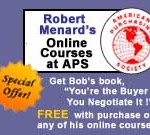
Robert Menard
Certified Purchasing Professional,
Certified Professional Purchasing Consultant, Certified Green Purchasing Professional, Certified Professional Purchasing Manager
There may be no more frustrating issue for participants in my purchasing training seminars than that of single and sole sources. It arises often, is poorly understood, and few know how to handle the challenges. Singe and sole sources are different problem with different solutions. Even the meaning of single and sole gets confused so let’s first define the terms.
A single source is one chosen at the purposeful exclusion of others. This partnering type of relationship usually evolves over time and is built upon the foundation of lowest Total Cost of Ownership . A sole source is one where you have no other choice. Usual causes are patented products/services, geographic rarity, and customer/end user requirement.
The single source is easier to manage provided your supplier management systems are robust. The buyer and seller concentrate on removing cost from the system at every opportunity. Generally, fewer problems are encountered and each party shares in the greater profitability that derives from the lowest TCO.
This success just does not materialize by happenstance. It begins with a vigorous supplier certification system. If all you require to hire a supplier is a “Pulse and a Price”, expect to be in deep into hot water at the worst possible time. A strong supplier evaluation system built around TCO is mandatory. Anyone who touches the process in a significant way should have input. Problems that arise are analyzed with a thorough post-mortem, including root cause analysis, and a solution put in place that eliminates a repeat. All this is easy to say, much work to do, but with good supplier management, worth every penny of investment. Otherwise, it may be time to change suppliers.
With a sole source, buyers generally start out at a steep disadvantage. The first question to answer is, “How much of a burn is this problem?” For instance, I once had a consulting client who whose tail was twisted because the supplier of a very popular author’s books (which became a hit movie series about kids and witchcraft) had jacked up the price to nearly double. Upon resale of the product, my client was taking in four times the margin. This is not a bad problem to have and is a wave worth riding. Don’t worry your tail being twisted if your pocket is being filled.
If the burn hurts, then you must decide if this is a book of business worth keeping. Such may be an executive management decision. In no case, however, should you roll over. Start with the Dutch Uncle speech that sounds like this. “Mister or Madame Supplier, we need to resolve a problem because if we cannot, I cannot sell to my customer and will no longer be a customer to you so what can we do?” The supplier may not care, in which case, it is better to know. At least, you have given them a chance to salvage the sole source relationship.
If the sole source is due to a patent or a geographic rarity (the mineral Rhodium is an example, so is air travel in many countries), you have a tougher job. You can try to qualify a substitute (often said and rarely done) or seek other means, such as train travel. Usually, the alternative is worse than the status quo in terms of TCO.
About the best of these sole source situations is the customer/end user requirement. In one such case years ago, my client’s customer, a big 3 auto manufacturer, specified the sub-assembly supplier we were mandated to by from the customer selected manufacturer. The supplier was cocky and felt bullet proof. The quality was superb but delivery was awful, service non-existent, and the price was what the big 3 customer specified. We documented the supplier’s failures, including one in which we could not supply our assembly because of the sole source supplier’s stock out. This problem culminated in a ”Come to Detroit” meeting in which the supplier was read the riot act and was forced to reimburse my client for its liquidated damages assesses by my client’s customer due to the sole source’s failure.
None of this is easy but you must be assiduous in your efforts, especially with sole sources.


